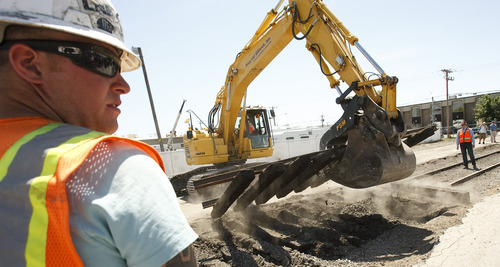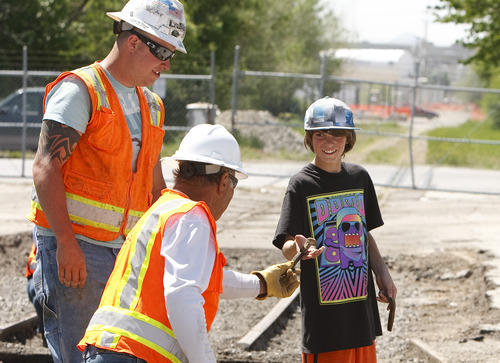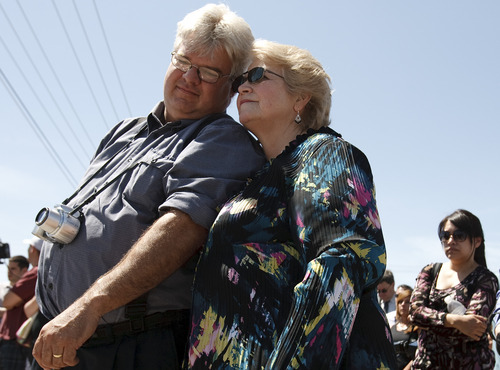This is an archived article that was published on sltrib.com in 2012, and information in the article may be outdated. It is provided only for personal research purposes and may not be reprinted.
Under the warm spring sun Wednesday, a crowd gathered at 2235 Main St. in South Salt Lake to celebrate the beginning of the long anticipated return of streetcars to the Salt Lake Valley.
U.S. Secretary of Transportation Ray LaHood joined several city officials, transit leaders and members of the community to savor the moment punctuated by the groundbreaking ceremony.
"You're all blessed here," LaHood said. "This is a celebration of a community coming together, of being of one mind, of being united behind the idea that you need to have a community that really reflects the next generation of transportation."
In a statement, Federal Transit Administrator Peter Rogoff called the project a smart investment that will serve as a win-win situation for area residents and Utah's energy future.
"Over the next twenty years, this federal investment in the Sugar House Streetcar project is anticipated to save more than 1 million gallons of fuel and reduce carbon emissions by 26,000 tons," Rogoff said.
By late 2013, modern streetcars will run along a new two-mile stretch of rail that will connect South Salt Lake's old warehouse district near the Central Pointe TRAX light rail station to the thriving commercial hub in Sugar House.
To make way for the new line, a large backhoe went to work lifting out the remains of old abandoned rails that once served the Denver & Rio Grande Western Railroad.
"What better way to kick this off, not as a groundbreaking but actually removing the last bits of rail left from this line and ushering out the past while we bring in the future," said Greg Hughes, who chairs the Utah Transit Authority board and also serves in the state House of Representatives.
The Salt Lake Valley hosted a thriving electric streetcar network in the early 1900s but they had made their last runs by 1946, giving way to bus and automobile travel. Now, streetcars are seeing a resurgence and are revitalizing urban neighborhoods around the nation.
Trail and green-space advocates pressed hard for preserving a greenway on the north and south sides of the streetcar corridor where strollers, cyclists and hikers could congregate and connect with one another.
Soren Simonsen, chair of the Salt Lake City Council, acknowledges getting teary-eyed over seeing the Sugar House rail/trail project coming to fruition.
"But this is more than that, you have to understand that trains run in my blood," Simonsen said, speaking of his great grandfather who immigrated from Denmark at the age of 12 and later served as Brigham City's mayor, bringing the first electrified trolleys to that community.
By the time construction culminates in 2013, Simonsen said he will have spent one-third of his life working to bring about the Sugar House Streetcar and Greenway project.
He's not the only one to dream big.
For over a decade, now former Salt Lake City resident Doug White — a satellite TV installer by profession — was driven by a desire to revive old-style trolley car traffic along this same corridor. He and his wife have since moved to Boise, but the couple returned Wednesday for the big announcement.
"I actually dreamed it in a dream," White said, noting that he first shared his vision years ago with D.J. Baxter, then the assistant mayor of Salt Lake City.
Parley's Trail promoter Lynne Olson recently organized Friends of the Sugar House Streetcar and noted Wednesday that the 1985 master plan for Sugar House included plans for a rail with trails development "in this very corridor."
"It seemed like it probably would never happen but we wanted to keep open the hope," Olson said.
In 2000, the Parley's Rails Trails and Tunnels (PRATT) coalition formed in support of an urban bicycle-pedestrian path to connect the Bonneville Shoreline Trail to the Jordan River Parkway.
"That's what we'll see coming soon, right here in this greenway," Olson said. "It's an amazing accomplishment."
The $37.2 million Sugar House project is funded from a $26 million federal Transportation Investment Generating Economic Recovery grant and $11.2 million from South Salt Lake, Salt Lake City and UTA funds.
UTA expects the project to generate 700 short-term construction jobs and to add 7,500 new jobs to the local economy by 2030. It also could generate over $1 billion in new business development along the line.
Riders should be able to use the new streetcar system, complete with seven stations, by the end of 2013.









